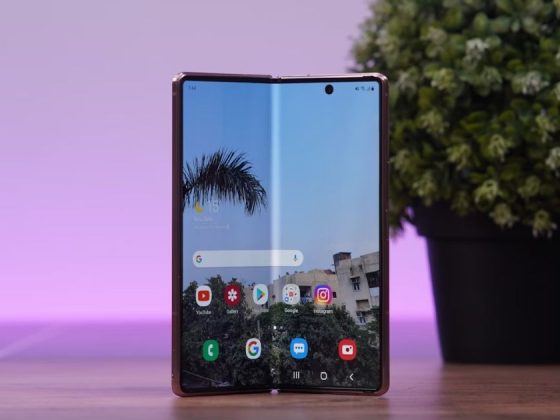Envision a world where smartphones are no longer physical objects that must be carried around. Instead, everything from apps to notifications to immersive experiences would be displayed directly within one’s line of sight, all made possible by a pair of smart contact lenses. While this may seem like science fiction, the technology is rapidly approaching reality. This article explores the transformative potential of smart contact lenses, their ability to replace smartphones, and their revolutionary impact on interactions with technology and the surrounding world.
What Are Smart Contact Lenses?
Smart contact lenses represent a groundbreaking advancement in wearable technology. They incorporate. They incorporate sensors, microprocessors, and other electronic components designed to integrate seamlessly with the human eye. These lenses go beyond traditional vision correction, potentially revolutionizing interactions with both digital environments and the physical world. With smart contact lenses, the functionalities of a smartphone could be projected directly into one’s line of sight, eliminating the need for a physical device.
How Smart Contact Lenses Work
At their core, smart contact lenses are designed to look and feel like regular contacts. The difference lies in their embedded technology. These lenses would be equipped with various components, including tiny displays, sensors, and wireless communication modules, enabling them to connect to the cloud and synchronize with other devices. The lenses would be powered through miniaturized power sources, such as energy harvesting from your body or wireless charging systems.
Key Components of Smart Contact Lenses:
- Microdisplay: A small, transparent display within the lens that can project images or text directly onto the user’s field of view.
- Sensors: These might include sensors for tracking eye movement, detecting glucose levels, or monitoring biometrics, providing a wealth of real-time health data.
- Wireless Connectivity: Smart lenses use Bluetooth or other wireless technologies to sync with smartphones, smartwatches, or external devices.
- Battery Source: These lenses may be powered by a small battery embedded within them or through energy harvesting methods, such as body heat or blinking.
While these technologies are still developing, the progress toward viable smart contact lenses is ongoing. Major companies, such as Google and Samsung, as well as startups, are exploring the possibility of integrating these lenses into everyday life.
Key Features and Benefits of Smart Contact Lenses
1. Hands-Free Notifications and Interactions
One of the most compelling features of smart contact lenses is their ability to receive notifications and interact with apps without requiring a smartphone screen. Imagine receiving a message or an alert in your peripheral vision, all while walking down the street or conversing with someone. This hands-free approach to notifications would provide convenience and efficiency not achievable with current mobile devices.
Potential Benefits:
- Enhanced Convenience: No need to take your phone out of your pocket or bag to check messages or emails.
- Instant Notifications: Receive real-time updates without breaking your focus or workflow.
- Improved Productivity: Quickly glance at your lenses for important updates, which can enhance your efficiency in meetings or during everyday tasks.
2. Augmented Reality (AR) Integration
Smart contact lenses could revolutionize the world of augmented reality. By projecting digital information onto the user’s field of vision, these lenses could enable AR experiences without the bulky headsets commonly associated with this technology. Whether navigating a new city, exploring a museum, or gaming, AR could become a more immersive and accessible experience with just a pair of lenses.
Possible Applications:
- Enhanced Navigation: Directions or points of interest could be displayed directly in your line of sight, guiding you through unfamiliar environments.
- Virtual Shopping: Imagine seeing product details, reviews, and price comparisons projected as you walk through a store, enhancing your shopping experience.
- Real-Time Data Overlays: In work environments, smart lenses could display real-time information, such as task lists, project updates, or even safety alerts, while leaving your hands free for other tasks.
3. Health Monitoring
Beyond the digital realm, smart contact lenses can monitor your health in real-time. By integrating sensors that can track glucose levels, blood pressure, hydration, and other vital metrics, these lenses could serve as a cutting-edge health monitoring tool, especially for individuals with chronic conditions.
Health Monitoring Benefits:
- Continuous Health Monitoring: Track your health metrics throughout the day without requiring specialized equipment or invasive procedures.
- Non-Invasive Monitoring: Unlike traditional methods, such as finger pricks for glucose tests, smart lenses could provide a non-invasive way to monitor your health.
- Preventive Care: Real-time health data could help prevent medical emergencies by alerting you to potential issues before they become serious.
4. Vision Correction and Enhancement
Like traditional contact lenses, smart lenses could offer vision correction for those with nearsightedness, farsightedness, or astigmatism. However, smart contact lenses could also provide additional features, such as automatic adjustments to lighting conditions or enhanced focus on objects in the periphery of your vision.
Vision-Related Features:
- Adaptive Lenses: Automatically adjust to different lighting conditions, providing a more comfortable viewing experience.
- Vision Enhancement: Enhanced contrast and focus for better clarity, especially in low-light environments.
5. Privacy and Security
With the ability to access and display sensitive information directly within your line of sight, privacy and security will be a top concern for smart contact lenses. Developers must implement robust security features to ensure that personal data is protected and that the lenses are resistant to hacking or unauthorized access.
Security Measures:
- Encrypted Communication: To protect sensitive data, smart contact lenses would employ end-to-end encryption for all wireless communications.
- Biometric Authentication: Authentication features, such as eye or retinal scans, could ensure that only the wearer can access the lenses’ functions.
The Impact on Everyday Life
1. Redefining Communication
Smart contact lenses have the potential to transform Communication significantly. Instead of reaching for a phone to reply to a text or browse social media, interactions could be driven by simple eye movements. By tracking the user’s gaze, these lenses could enable effortless interaction with apps, messages, and notifications, allowing for quicker responses and more fluid Communication without the need for physical devices. This innovation promises to make Communication more seamless and efficient, creating a hands-free, intuitive experience.
Communication Possibilities:
- Instant Messaging and Social Media: Reply to messages or browse your social media feed directly through your lenses.
- Video Calls: Make video calls where the lens acts as the camera, displaying the conversation directly in your line of sight.
- Eye Gestures: Simple eye movements could be used to scroll through notifications, select options, or interact with apps, reducing the need for manual input.
2. Changing How Content is Consumed
Smart contact lenses have the potential to transform how digital content is consumed, whether through watching videos, playing games, or reading articles. Instead of focusing on a traditional screen, users could enjoy an immersive experience directly in their line of sight, opening up new possibilities for entertainment, education, and professional development. This technology has the potential to redefine how people interact with and engage in digital media, offering a more dynamic and hands-free approach to content consumption.
Content Consumption Changes:
- Immersive Video: Watch videos directly through the lenses in a cinematic, 360-degree view.
- Gaming: Augmented reality gaming could provide a more immersive and hands-free experience, enabling players to interact with digital worlds without the need for controllers or screens.
- E-Learning: Participate in real-time, interactive learning experiences with AR-enhanced content displayed through the lenses.
Challenges to Overcome
While the potential of smart contact lenses is undoubtedly exciting, several challenges need to be addressed before they can become a widespread reality.
1. Technical Limitations
Developing the necessary technology to create functional smart lenses presents several technical hurdles. The technology is still in its infancy, from ensuring the lenses are comfortable and lightweight to integrating advanced features like AR displays, health sensors, and wireless connectivity.
2. Power Supply and Battery Life
A major challenge is creating a reliable power supply for the lenses. Current battery technology is not yet sufficiently small or efficient to support the power requirements of smart contact lenses without requiring frequent recharging.
3. Privacy Concerns
Smart contact lenses would have access to sensitive personal data, such as location information, biometric data, and personal messages. This raises significant privacy concerns, as hackers could potentially access this data. Stringent privacy protections and encryption measures will be necessary to ensure that users’ data remains secure and confidential.
4. Ethical Implications
The ability to record everything seen through smart contact lenses raises significant ethical concerns surrounding surveillance, consent, and personal privacy. With the potential for continuous data collection, questions about who controls this information and how it is used become increasingly important. As with any emerging technology, society must address the moral implications of widespread adoption, ensuring safeguards are in place to protect individuals’ privacy while balancing innovation with ethical responsibility.
The Future of Smart Contact Lenses
Despite the obstacles, the future of smart contact lenses holds immense potential. As technology progresses, these lens prototypes are expected to become more functional, integrating seamlessly into daily life. The ability to access and interact with digital content in such an immersive, hands-free manner could revolutionize industries across healthcare, entertainment, and retail.
As society advances toward a more connected, tech-driven world, smart contact lenses may play a pivotal role in how individuals experience and engage with their surroundings. From health monitoring and Communication to entertainment, the potential applications are vast, offering endless possibilities for enhancing daily life and transforming various sectors.
Smart Contact Lenses: Shaping the Future of Wearable Technology
Smart contact lenses are not merely a futuristic concept; they signify the next evolution in wearable technology. With the potential to replace smartphones, deliver immersive augmented reality experiences, monitor health, and revolutionize Communication, these lenses are poised to become integral to daily life. While significant challenges remain, the ongoing advancements in this field offer a glimpse into a future where technology is seamlessly integrated into vision, and hands-free interaction with the digital world becomes the standard. Looking ahead, it is evident that smart contact lenses will be among the most groundbreaking innovations of the coming decade.





